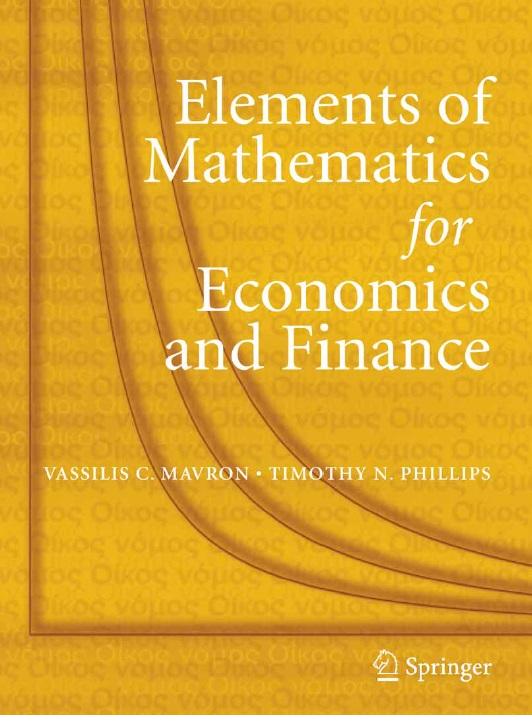The mathematics contained in this book for students of economics and finance has, for many years, been given by the authors in two single-semester courses at the University of Wales Aberystwyth. These were mathematics courses in an economics setting, given by mathematicians based in the Department of Mathematics for students in the Faculty of Social Sciences or School of Management. The choice of subject matter and arrangement of material reflect this collaboration and are a result of the experience thus obtained. The majority of students to whom these courses were given were studying for degrees in economics or business administration and had not acquired any mathematical knowledge beyond pre-calculus mathematics, i.e., elementary algebra. Therefore, the first-semester course assumed little more than basic precalculus mathematics and was based on Chapters 1–7. This course led on to the more advanced second-semester course, which was also suitable for students who had already covered basic calculus. The second course contained at most one of the three Chapters 10, 12, and 13. In any particular year, their inclusion or exclusion would depend on the requirements of the economics or business studies degree syllabuses. An appendix on differentials has been included as an optional addition to an advanced course. The students taking these courses were chiefly interested in learning the mathematics that had applications to economics and were not primarily interested in theoretical aspects of the subject per se. The authors have not attempted to write an undergraduate text in economics but instead have written a text in mathematics to complement those in economics. The simplicity of a mathematical theory is sometimes lost or obfuscated by a dense covering of applications at too early a stage. For this reason, the aim of the authors has been to present the mathematics in its simplest form, highlighting threads of common mathematical theory in the various topics of economics. Some knowledge of theory is necessary if correct use is to be made of the techniques; therefore, the authors have endeavoured to introduce some basic theory in the expectation and hope that this will improve understanding and incite a desire for a more thorough knowledge. Students who master the simpler cases of a theory will find it easier to go on to the more difficult cases when required. They will also be in a better position to understand and be in control of calculations done by hand or calculator and also to be able to visualise problems graphically or geometrically. It is still true that the best way to understand a technique thoroughly is through practice. Mathematical techniques are no exception, and for this reason the book illustrates theory through many examples and exercises.
چکیده فارسی
ریاضیات موجود در این کتاب برای دانشجویان اقتصاد و مالی سالها است که توسط نویسندگان در دو دوره تک ترم ارائه شده است در دانشگاه ولز Aberystwyth. اینها دروس ریاضی بودند یک محیط اقتصادی، ارائه شده توسط ریاضیدانان مستقر در بخش ریاضیات برای دانشجویان دانشکده علوم اجتماعی یا دانشکده مدیریت. انتخاب موضوع و چیدمان مطالب نشان دهنده این موضوع است همکاری و نتیجه تجربه به دست آمده است. اکثر دانشجویانی که این دوره ها به آنها داده می شد در حال تحصیل بودند برای مدرک اقتصاد یا مدیریت بازرگانی و کسب نکرده بود هر دانش ریاضی فراتر از ریاضیات پیش از حساب، یعنی ابتدایی جبر بنابراین، دوره ترم اول کمی بیشتر از پیش محاسبات اولیه را در نظر گرفت ریاضیات و بر اساس فصل های 1-7 بود. این دوره منجر به دوره ترم دوم پیشرفته تر که برای دانشجویان نیز مناسب بود که قبلاً محاسبات پایه را پوشش داده بودند. دوره دوم حداکثر شامل یکی از سه فصل 10، 12 و 13. در هر سال خاص، گنجاندن آنها یا حذف به الزامات اقتصاد یا تجارت بستگی دارد برنامه های درسی مدرک تحصیلی یک ضمیمه در مورد دیفرانسیل به عنوان یک اضافه شده است علاوه بر اختیاری به یک دوره پیشرفته دانشآموزانی که این دورهها را میگذرانند، عمدتاً علاقهمند به یادگیری بودند ریاضیاتی که در اقتصاد کاربرد داشتند و در درجه اول علاقه ای نداشتند در جنبه های نظری موضوع فی نفسه. نویسندگان تلاش نکرده اند برای نوشتن یک متن در مقطع کارشناسی در اقتصاد اما در عوض نوشته اند متنی در ریاضیات برای تکمیل متن در اقتصاد. گاهی اوقات سادگی یک نظریه ریاضی از بین می رود یا مبهم می شود با پوشش متراکم برنامه ها در مراحل اولیه. به همین دلیل، هدف نویسندگان ارائه ریاضیات به ساده ترین شکل آن بوده است. برجسته کردن موضوعات نظریه رایج ریاضی در موضوعات مختلف اقتصاد. اگر بخواهیم از آن به درستی استفاده کنیم، دانش تئوری لازم است تکنیک؛ بنابراین، نویسندگان تلاش کرده اند تا برخی از اصول را معرفی کنند نظریه در انتظار و امید است که این امر باعث بهبود درک و میل به دانش کامل تر را برانگیزد. دانشآموزانی که بر موارد سادهتر یک نظریه تسلط دارند ادامه دادن به آن آسانتر خواهد بود به موارد دشوارتر در صورت لزوم. آنها همچنین در موقعیت بهتری خواهند بود برای درک و کنترل محاسبات انجام شده توسط دست یا ماشین حساب و همچنین بتواند مسائل را به صورت گرافیکی یا هندسی تجسم کند. این است هنوز درست است که بهترین راه برای درک کامل یک تکنیک از طریق آن است تمرین. تکنیک های ریاضی نیز از این قاعده مستثنی نیستند و به همین دلیل است کتاب تئوری را از طریق مثالها و تمرینهای بسیاری نشان میدهد.
ادامه ...
بستن ...
Author(s): Vassilis C. Mavron, Timothy N. Phillips Publisher: Springer, Year: 2007 ISBN: 9781846285615,1-84628-561-5,1846285607,9781846285608 Pages : 321 Language : English Size : 2 Mb Extension : pdf
ادامه ...
بستن ...










